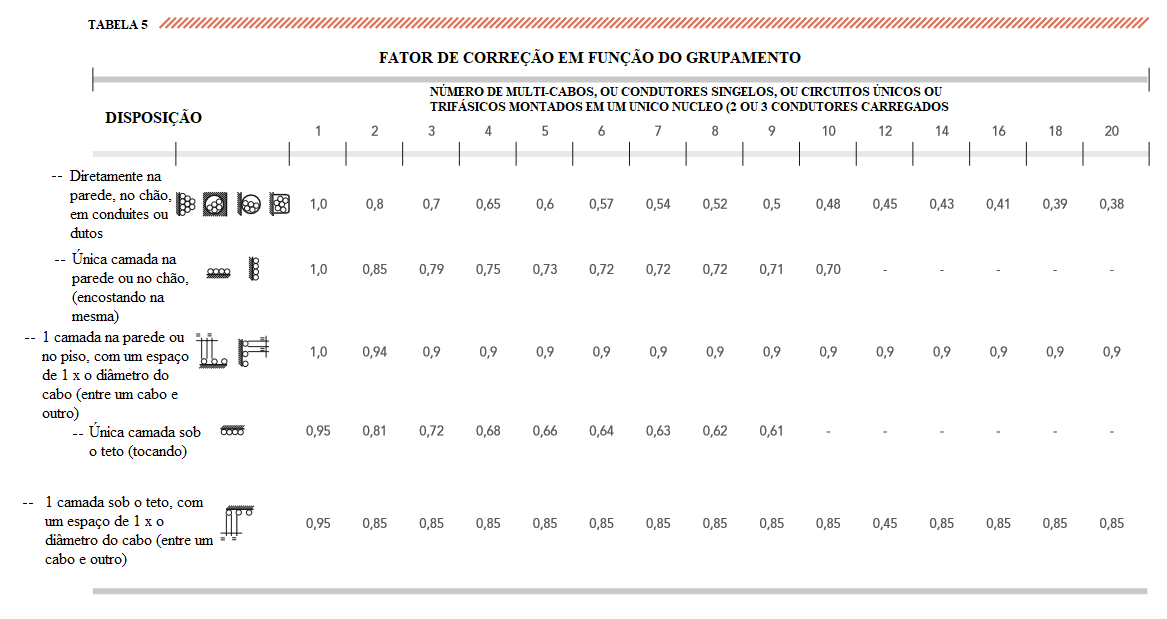ACADEMY OF KNOWLEDGE
APPLICATION AND INSTALLATION OF MOBILE CABLES - OVERHEAD TRAVELLING CRANES, CRANES, FESTOONS, LIFTS, CRANE BELTS...
RADIUS OF CURVATURE
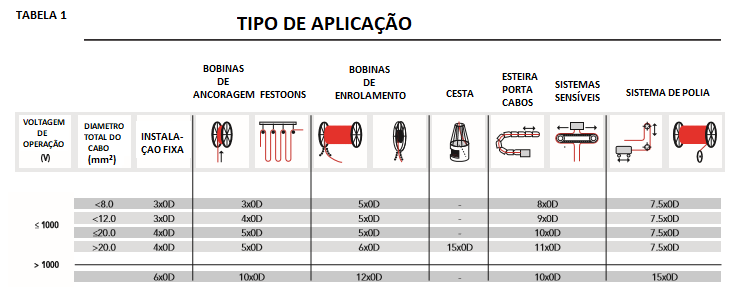
These are the minimum bending radii for use in the different applications. You must strictly follow these recommendations and perform the correct bending calculation in order to obtain the best result and durability of the cable. Never increase the minimum bending radius stipulations because it causes elongation and internal torsions compromising the service life. The frequency of movement must also be taken into account, because if it is of low demand, the minimum bending radius may be tightened (slow or few movements).
The table above gives the minimum recommended bending radii for different cable uses. Compliance with these recommendations and an accurate bending radius calculation is important as one of the most important reliability factors. Increasing the minimum bending radius has a more than proportional effect on the service life of a cable because it causes elongation and internal twisting due to increased mechanical stresses on the conductors.
INSTALLATION - ANALYSIS OF THE CABLE GUIDE
- Always use guides that allow the best bending radius with the smallest possible deflection.
- Always keep the guides aligned to avoid twisting.
A one-way system appears to be more economically advantageous. However, a considerable increase in rope life is obtained if a two-way guide is used: This does not occur if the winding system is fed at the end, remaining in contact with the rope regardless of the direction of travel of the machine.


Avoid any abrupt change of the bending radius, otherwise it may lead to a cable break.
Always use voltage protection systems when laying the cable. The working voltages and protection devices must be defined in accordance with the parameters defined for each cable section.
INSTALLATION - PULLEY ANALYSIS

INCORRECT APPLICATION ON THE POLY: Effect induces torsion in the cable due to the rolling effect reducing its useful life.

CORRECT APPLICATION ON THE POLY: Manner that minimizes the torsion applied to the cable.
INSTALLATION - CHANGE OF DIRECTION
INSTALLATION - ANCHOR SYSTEM
The most common mobile anchorage points are the "cable grips" type terminals. The load tension must be distributed along the whole cable length between 20 to 25 x its total diameter. In order to maintain operational movements leave a cable surplus before the entrance to the terminal box. When the centre point inner fitting is installed, the vertical distance between the entry mouth and the crane guide must not be less than 15 times the total cable diameter or 1m, use whichever is greater. At least 2 turns of cable must be made around the fixed relief drum to ensure sufficient contact area for proper stressing to occur.
Dynamic strain on the cable can lead to premature failure, especially in high speed applications. To minimise this, various solutions can be used, but be aware of the speed reduction device. It is interesting to apply this system to your reel drive design, reducing the speed before reaching the centre point, then re-accelerating after passing the centre point and the direction of rotation of the reel has been reversed.

- Cable holder
- Inlet
- Anti-stress rolling drum*
- Cable wound twice on the anti-stress winding drum
- Power cable
- Terminal box
- Clamp
*(For Medium Voltage cables = 10 x Total Diameter; For Low Voltage cables = 5 x Total Diameter)
INSTALLATION - REEL TYPES (DRUMS)
1-) Mono spiral reel: this is the most common, with a simple guide route that gives the cable a longer life than other types. Also in these cable reels due to improved heat dissipation, the conductor size in power cables is generally smaller compared to other types of reels. The diameter and length of the cable is a major factor and must be taken into account when applying mono-spiral reels: good counterbalance between the inner and outer diameter of the reel will be critical in determining and controlling the tension of the cable.
2-) Bobina de Torção Aleatória: O tipo mais simples de carretel existente. Ele opera sem guias e as camadas aleatórias podem criar dificuldades operacionais severas, tais como, derrapagem da bobina, força de tração abrupta, torções, abrasões e acúmulos anormais. Por estes motivos, esta aplicação pode suportar apenas pequenos diâmetros de cabo e corridas curtas: 250 m de corrida máxima e um peso aproximado <4 kg / m.
3-) Multi Spiral Reel: Used when the cable has a large diameter and long lengths. The main advantage of using this type of spool is its ability to transport large amounts of cable (even with large diameters) with constant winding tension and long distances. On the other hand, usually due to the location of the spool, it is also difficult to reduce the number of guides and changes of direction on this type of installation.
COILS - HANDLING AND STORAGE
It is recommended to store and handle the cables on their respective reels in order to avoid defects caused by loose cables.
Avoid rolling the drums on their flanges, use a fork lifter or crane to move the reel, if you cannot avoid rolling, do it against the winding direction in order to keep the cable tight to the reel and prevent twisting or abrupt tensions.

- Move as close to the ground as possible.
.- Move slowly and when in the correct location, do not make an abrupt stop.
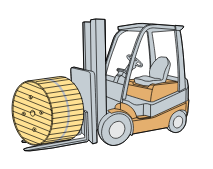
* Attention:
- Place the coil in the centre of the fork.
- The width of the fork should be greater than the coil.
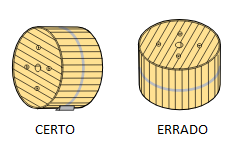
- Do not cover the coils.
- Do not roll more than 20m.
- Do not use sharp objects when moving.
- Do not roll a damaged coil.
- Do not roll on an uneven surface.
- Do not store the coil near heaters or inflammable places.
CABLE INSTALLATION

REMOVAL OF THE TWIST:

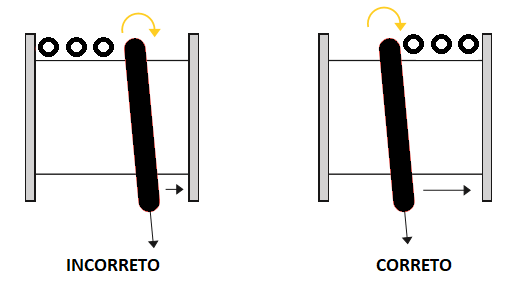
INSTALLATION - VERTICAL APPLICATIONS - REELFLEX (K)NSHTÖU-J / (N)SHTÖU-J # REELFLEX PUR-HF # FESTFLEX (N) GRDGÖU
The best result is obtained with a stress relieving coil. The open end construction makes installation and replacement easier by providing better stress relief and protection of the outer jacket than tightening the cable. Make at least 2 turns of cable around the drum. Table 1 (Bending Radius) shows the minimum bending radii for stress relief. If, on the other hand, anchoring is done with a tightening over the cover, a recommended length of cover over the cable is approximately 25 times the overall diameter of the cable. This will help spread the dynamic stresses over a sufficient surface area of the outer jacket to inhibit damage to the cable.

REELFLEX (K)NSHTÖU-J / (N)SHTÖU-J and REELFLEX PUR-HF CABLE
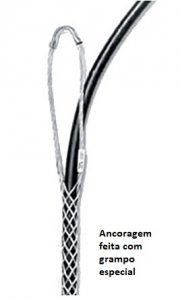
FESTFLEX (N) GRDGÖU - BASKET APPLICATIONS
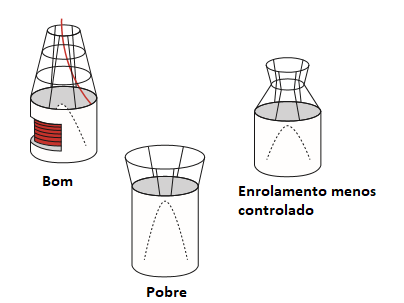

ELECTRICAL PARAMETERS
They are used in the flexible cables for voltage testing as required by DIN VDE 0250.

CALCULATION OF CABLE CROSS SECTION
CURRENT CAPACITY FOR CONTINUOUS OPERATION
The calculation was made according to VDE as a precaution because of the greater difficulties with heat dispersion for these types of cables. The values are for three-core cables, with or without earth conductor, without movement with the cable on the ground and with an ambient temperature of 30°C. For installations where it is known that cable life will be reduced as a result of high mechanical stress or wear on the outer jacket thermal ageing will be of lesser importance. A maximum operating temperature of 90°c may be considered in this case and the capacities given in Table 3 increased by approximately 7%.


